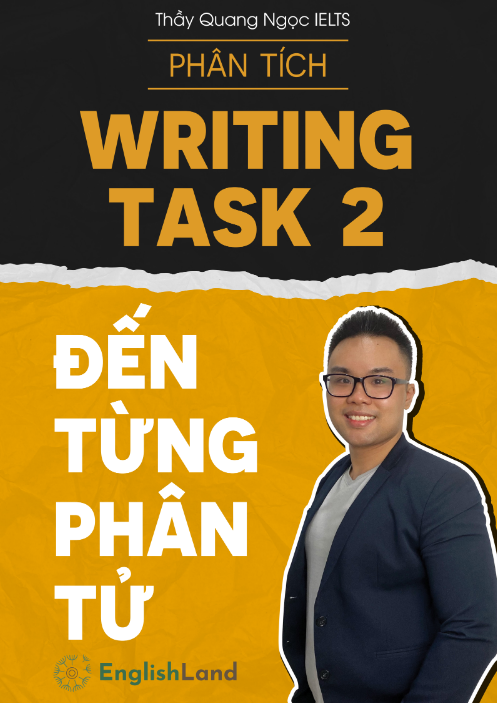


MỤC LỤC
5 KÊNH CHÍNH THỨC CỦA THẦY QUANG NGỌC IELTS ………………………………………………………………… 1
LỜI NÓI ĐẦU ………………………………………………………………………………………………………………………………… 2
1. WRITING LÀ MỘT BÀI TOÁN ………………………………………………………………………………………………………. 6
- TOPIC VOCABULARY ………………………………………………………………………………………………………………. 7
- STRUCTURE …………………………………………………………………………………………………………………………………. 9
- CẤU TRÚC 2552 ………………………………………………………………………………………………………………………… 13
- CÁC DẠNG WRITING TASK 2 …………………………………………………………………………………………………. 21
4.1 DẠNG AGREE/DISAGREE …………………………………………………………………………………………………… 21
4.2 DẠNG ADVANTAGES/DISADVANTAGES ………………………………………………………………………… 23
4.3 DẠNG DISCUSS BOTH VIEWS …………………………………………………………………………………………….. 25
4.4 DẠNG TWO-PART: PROBLEMS/SOLUTIONS …………………………………………………………………. 26
4.5 DẠNG TWO-PART: CÒN LẠI ……………………………………………………………………………………………….. 29
2. MỞ BÀI ………………………………………………………………………………………………………………………………………… 31
- GENERAL STATEMENT …………………………………………………………………………………………………………. 31
- OPINION ……………………………………………………………………………………………………………………………………… 35
- PRACTICE 1 …………………………………………………………………………………………………………………………………. 37
- THAM KHẢO 8 MỞ BÀI …………………………………………………………………………………………………………… 42
- PHÂN TÍCH CHUYÊN SÂU ……………………………………………………………………………………………………….. 51
- PRACTICE 2 ………………………………………………………………………………………………………………………………… 61
3. TOPIC SENTENCE ………………………………………………………………………………………………………………………. 65
- TOPIC: NEWSPAPER AND BOOKS ………………………………………………………………………………………. 65
- TOPIC: CARS AND BICYCLES ………………………………………………………………………………………………… 66
- TOPIC: CULTURE ……………………………………………………………………………………………………………………….. 68
- TOPIC: ADVERTISING ………………………………………………………………………………………………………………. 70
- TOPIC: HISTORICAL BUILDINGS ………………………………………………………………………………………….. 72
4. BRAINSTORMING ……………………………………………………………………………………………………………………… 73
- DẠNG AGREE/DISAGREE ……………………………………………………………………………………………………….. 73
- DẠNG ADVANTAGES/DISADVANTAGES …………………………………………………………………………….. 74
- DẠNG DISCUSS BOTH VIEWS ………………………………………………………………………………………………… 75
- DẠNG TWO-PART: PROBLEMS – SOLUTIONS ……………………………………………………………………. 76
- DẠNG TWO-PART: CÒN LẠI …………………………………………………………………………………………………… 77
- PRACTICE ……………………………………………………………………………………………………………………………………. 78
- THAM KHẢO BRAINSTORMING …………………………………………………………………………………………….. 82
5. HẠT GIỐNG ………………………………………………………………………………………………………………………………… 95
- PRACTICE ………………………………………………………………………………………………………………………………….. 100
- THAM KHẢO “HẠT GIỐNG” …………………………………………………………………………………………………. 103
- TĂNG TRƯỞNG ……………………………………………………………………………………………………………………… 112
6. ĐẶT BÚT …………………………………………………………………………………………………………………………………… 117
- CHỨNG MINH TỐT ………………………………………………………………………………………………………………… 118
- CHỨNG MINH XẤU ………………………………………………………………………………………………………………… 121
- QUAN HỆ NHÂN QUẢ ……………………………………………………………………………………………………………. 124
7. TEMPLATE 2552 IMPROVISED ……………………………………………………………………………………………… 127
- AGREE/DISAGREE …………………………………………………………………………………………………………………. 128
- ADVANTAGES/DISADVANTAGES ……………………………………………………………………………………….. 130
- DISCUSS BOTH VIEWS ……………………………………………………………………………………………………………. 132
- TWO-PART QUESTIONS …………………………………………………………………………………………………………. 134
8. THÀNH HÌNH ……………………………………………………………………………………………………………………………. 136
- WRITING LÀ MỘT BÀI TOÁN ……………………………………………………………………………………………….. 138
- MỞ BÀI ……………………………………………………………………………………………………………………………………… 138
- BRAINSTORMING …………………………………………………………………………………………………………………… 139
- VIẾT BÀI ……………………………………………………………………………………………………………………………………. 140
9. PHÂN TÍCH ĐẾN TỪNG PHÂN TỬ …………………………………………………………………………………………… 145
- AGREE/DISAGREE …………………………………………………………………………………………………………………. 146
1.1 TOPIC: NEWSPAPERS AND BOOKS …………………………………………………………………………….. 146
1.2 TOPIC: CULTURAL DIVERSITY …………………………………………………………………………………….. 158
1.3 TOPIC: HOME COOKING …………………………………………………………………………………………………. 168
1.4 TOPIC: SMOKING ……………………………………………………………………………………………………………… 178
1.5 TOPIC: SOCIAL NETWORK ……………………………………………………………………………………………… 195 - ADVANTAGES/DISADVANTAGES ……………………………………………………………………………………….. 208
2.1 TOPIC: ROBOTS AND JOBS ……………………………………………………………………………………………. 208
2.2 TOPIC: PERSONAL INFORMATION ……………………………………………………………………………… 221 - DISCUSS BOTH VIEWS …………………………………………………………………………………………………………….. 234
3.1 TOPIC: ARTIFICIAL INTELLIGENCE …………………………………………………………………………….. 234
3.2 TOPIC: HUMANS AND THE ENVIRONMENT …………………………………………………………………. 246
3.3 TOPIC: CHILDREN AND CRIME ……………………………………………………………………………………… 258
3.4 TOPIC: FAMILY HISTORY ……………………………………………………………………………………………….. 263
3.5 TOPIC: TRANSPORTATION ……………………………………………………………………………………………… 279
3.6 TOPIC: WILD ANIMALS …………………………………………………………………………………………………… 294 - TWO-PART QUESTIONS …………………………………………………………………………………………………………. 308
4.1 TOPIC: LIFE IN CITIES ……………………………………………………………………………………………………….. 308
4.2 TOPIC: CARS AND BICYCLES …………………………………………………………………………………………. 313
4.3 TOPIC: MODERN ELECTRONICS ……………………………………………………………………………………. 324
4.4 TOPIC: CRIME ……………………………………………………………………………………………………………………. 341
4.5 TOPIC: INTERNET ……………………………………………………………………………………………………………… 356
4.6 TOPIC: LUXURIOUS ITEMS ……………………………………………………………………………………………… 370
4.7 TOPIC: RUBBISH ………………………………………………………………………………………………………………… 386
4.8 TOPIC: SUGAR-BASED DRINKS ……………………………………………………………………………………. 400
10. ĐỪNG QUÊN ………………………………………………………………………………………………………………………….. 414
1. WRITING LÀ MỘT BÀI TOÁN
Hãy nhìn vào bài Sample Writing Task 2 dưới đây:
Đề bài:
Many old buildings are protected by law because they are part of a nation’s history.
However, some people think they should be knocked down to make way for new ones because people need houses and offices.
To what extent do you agree or disagree?
Bài viết mẫu:
It is evident that there are numerous legally protected historical structures. Nonetheless, many have called into question the demolition of these historic buildings in favour of modern ones, the likes of which are houses and offices to accommodate the growing demand of today’s world. Despite the practicality of modern architectures, it is my strong belief that the upkeep of older structures is of astronomical importance as they serve to inform the public regarding a country’s history.
Advocates of modernity gravitate towards prioritising a building’s functionalities. The ever-growing urban populations are associated with a surge in demand for accommodations in metropolises with high population densities. Policymakers, therefore, enact housing policy reforms to ease the pressure on low-income city dwellers living largely in populous slum areas notoriously known for appalling sanitation, inadequate health facilities, and sorely lacking amenities. In addition, it is justifiable for old buildings that no longer meet today’s safety standards to be bulldozed at the expense of modern infrastructure and amenities. Newly-developed schemes, such as residential blocks and office spaces, serve vital functions in a 21st-century metropolis and are not merely for show, otherwise, would their planning not have been executed.
Despite the aforementioned merits of new developments, I would argue that historical constructions carry forth great aesthetic values and glorify our ancestors. The artistry can be best evidenced in the construction of the pyramids whose grandeur is still today hardly surpassed. Not only have these architectural marvels stood the test of time, many of the artworks inside also fill beholders with wonder and attract tourists from around the globe. Additionally, the preservation of historic buildings represents the utmost appreciation and admiration for our ancestors. By visiting architectural splendours marking glorious historical events and figures, visitors are instilled a sense of patriotism through acquiring a deeper understanding of our forefathers’ perseverance and resilience.
In conclusion, though modern buildings accommodate the surging urban populations, I am inclined towards the preservation of old structures owing to their vital importance in a nation’s history. Therefore, governments striving to strike the balance between both endeavours will reap the rewards of a more unified citizenry.
(351 words — Band 8.0+ — Written by Thầy Quang Ngọc IELTS)
1.1 TOPIC VOCABULARY
Nếu như bạn chưa biết, bạn nên dành khoảng 40 phút cho phần Writing Task 2 trong bài thi IELTS.
Phần lớn người học khi mới bắt đầu đều băn khoăn:
“Làm thế nào để viết được bài luận tối thiểu 250 từ trong vòng 40 phút — bài đó lại phải chặt chẽ, mạch lạc, có từ vựng phù hợp với topic, không sai ngữ pháp và có cấu trúc câu đa dạng?”
Hãy nhớ rằng:
| Tiêu chí | Tên viết tắt | Ý nghĩa |
|---|---|---|
| Task Achievement / Task Response | [T] | Độ chặt chẽ, đúng yêu cầu đề bài |
| Coherence and Cohesion | [C] | Tính mạch lạc, liên kết logic |
| Grammar | [G] | Cấu trúc ngữ pháp và độ chính xác |
| Vocabulary (Lexical Resource) | [V] / [L] | Từ vựng, khả năng paraphrase và độ tự nhiên |
Đây là bộ tiêu chí “BIG FOUR” — bạn phải thực hiện được tất cả trong 40 phút.
Bài viết không phải là bài văn — mà là một bài toán
Nếu bạn nghĩ bài mẫu ở trên là một bài văn hay, hãy thử đổi góc nhìn: đó thực chất là một bài toán logic, trong đó mỗi câu đều được đặt đúng vị trí để giải quyết từng biến số trong đề bài.
Hãy cùng “bóc tách” đề bài ra:
Many old buildings are protected by law because they are part of a nation’s history.
However, some people think they should be knocked down to make way for new ones because people need houses and offices.
To what extent do you agree or disagree?
Các từ khóa chính trong đề bài là:
“old buildings”, “protected by law”, “a nation’s history”, “knocked down”, “new ones”, “houses and offices”.
Chúng ta có thể chia nhóm chủ đề như sau:
| Nhóm chủ đề | Từ khóa chính | Gợi ý từ vựng mở rộng |
|---|---|---|
| 1. Housing / Construction / Buildings | old buildings, new ones, houses, offices | structures, demolish/demolition, flatten, functionalities, urban, metropolis, architectural marvels, works of art, splendours |
| 2. Law (Pháp luật) | protected by law | backed by law, legally protected, lawmakers, policymakers |
| 3. History (Lịch sử) | a nation’s history | historical structures, historic buildings, heritage sites, patriotism, forefathers, perseverance, resilience |
Đây chính là cách ép não làm việc — chia đề thành cụm chủ đề rõ ràng, từ đó “khơi” ra vốn từ chủ đề mà bạn đã học.
1.2 STRUCTURE – Cấu trúc của một bài Writing Task 2
Khi đã xác định được các chủ đề và từ vựng, nhiệm vụ tiếp theo là sắp xếp chúng theo cấu trúc logic.
Bài mẫu ở trên được tổ chức theo khung sau:
| Phần | Loại câu / Mục đích | Ví dụ trong bài mẫu |
|---|---|---|
| MỞ BÀI | General Statement | Paraphrase lại đề bài. “It is evident that there are numerous legally protected historical structures…” |
| Opinion | Trình bày quan điểm rõ ràng. “Despite the practicality of modern architectures, it is my strong belief that…” | |
| THÂN BÀI 1 | Topic Sentence | “Advocates of modernity gravitate towards prioritising a building’s functionalities.” |
| Supporting Idea 1 + Explanation | Trình bày luận điểm và giải thích. | |
| Supporting Idea 2 + Example | Nêu thêm luận điểm hoặc dẫn chứng cụ thể. | |
| THÂN BÀI 2 | Topic Sentence | “Despite the aforementioned merits of new developments, I would argue that historical constructions carry forth great aesthetic values…” |
| Supporting Idea 1 + Explanation | Đưa ví dụ (pyramids, architectural marvels…). | |
| Supporting Idea 2 + Explanation | Liên hệ tới giá trị văn hóa, tinh thần, lòng yêu nước. | |
| KẾT LUẬN | Conclusion | Khẳng định lại quan điểm. |
| Extension | Mở rộng thêm một nhận định / định hướng: “Therefore, governments striving to strike the balance…” |
Lưu ý quan trọng:
- Câu Topic Sentence phải ngắn gọn và rõ ràng, chứa ý chính của cả đoạn.
- Mỗi đoạn thân bài nên có 2 luận điểm, mỗi luận điểm đi kèm 1 phần giải thích hoặc ví dụ.
- Câu Conclusion tóm tắt toàn bài, có thể paraphrase lại opinion hoặc 2 topic sentence.
- Câu Extension giúp bài kết thúc tự nhiên, thể hiện khả năng tư duy rộng.
1.3 CẤU TRÚC 2552
Sau khi nắm được logic trên, ta có thể hệ thống lại thành cấu trúc “kinh điển” trong IELTS Writing Task 2 — Cấu trúc 2552.
| Phần | Cấu trúc | Chức năng |
|---|---|---|
| Introduction | General Statement → Opinion | Giới thiệu + Nêu quan điểm |
| Body 1 | Topic Sentence → Supporting Idea 1 → Explanation / Example → Supporting Idea 2 → Explanation / Example | Trình bày 2 luận điểm đầu |
| Body 2 | Topic Sentence → Supporting Idea 1 → Explanation / Example → Supporting Idea 2 → Explanation / Example | Trình bày 2 luận điểm sau |
| Conclusion | Conclusion → Extension | Tóm tắt + mở rộng kết bài |



